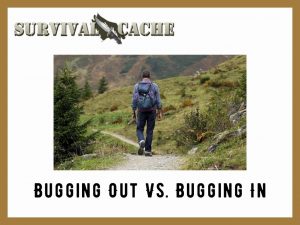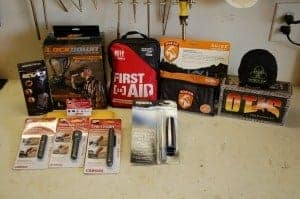One topic that is extensively covered in the prepping and survival community is bugging out vs bugging in. There is a lot of debate as to which one is better, how you should prepare for each, and in some cases, if bugging in or out is even feasible.
First, let me briefly define these two terms just so we are all on the same page:
SKIP AHEAD
Quick Definitions
Bugging Out

This is a term that was taken from the military. When there is a likely chance of an enemy force overtaking a base or compound, the call goes out to “bug out.”
When this happens, personnel grab their essentials so that they can leave the area and survive for a short period before receiving resupply or reinforcements.
In the civilian world, it is used similarly. When a dangerous threat enters the area in which a person lives it may force them to leave their home. They grab the supplies they can and leave or “bug out.”
Bugging In
Bugging in is the opposite of bugging out and many people use the term “shelter in place,” which means the same thing.
Simply put, a dangerous event happens that requires a person to bug in or shelter in place for their safety. Depending on what dangerous situation presents itself, it is safer to stay where you are than to attempt moving somewhere else.
Two Quick Examples
To better visualize bugging in vs bugging out, here are two examples.
But Out Example:
A raging wildfire is racing toward a person’s home. For their safety, they must leave the area rather than stay in their current location. The fire would cause the person to bug out.
Bug In Example:
A biohazard, such as a pandemic, could make it dangerous to travel – or even step outside of your home. This risk to person’s safety would cause them to bug in.
Bugging Out vs Bugging In – What Should You Choose?

Some people have extensive plans for bugging in, bugging out, or a mixture of the two.
The choice of staying or leaving is entirely dependent on the type of emergency scenarios that can happen, and a person’s particular circumstances.
For instance, it may not be an option for someone to bug out if they have a sick and immobile loved one at home. Due to outside forces, it may be safer for the person to leave but their situation may dictate that they stay, ride out the storm, and do the best they can.
Because a person never knows what is going to be thrown at them, it makes more sense to plan for both bugging in and bugging out, rather than for just one of them.
To do that, I am going to break down each of these into a little more detail.
Check out our article on should you buy a bug out property as well…
My Thoughts About Bugging In
Bugging in can happen anywhere at any time.
Have you ever been ready to leave work and a bad storm rolls through? Usually, when this happens it is recommended by the employer that employees do not leave and seek shelter within.
This is a short-term example of bugging in.
Typically, a person will be doing this at home, which is generally the safest place they can because it is the most comfortable, they are the most familiar with it, and it has the most storage space for supplies.
Most people would say that bugging in gives you the “home field advantage.”
Knowing exactly what kind of supplies you should have when bugging in can be tricky. This is because you never know what will cause you to shelter in place and for how long.
Scenarios range from a bad storm that could keep you in one place for just a few hours to possibly days, to more wide-reaching events that could last weeks, months, or even years.
The last thing you should be doing when disaster strikes is making a supplies run. This can be a bad idea for a variety of reasons.
No matter what causes you to bug in there are some common items that everyone should have that would allow a person to bug in for as long as possible and to be more self sufficient.
Common sense dictates that the best course of action is to get everything you need ahead of time before disaster strikes. Below are some common items to have:
- Water
- Bottled water
- Food
- Ways of regulating body temperature
- Medical supplies, a proper first aid kit
- Sanitation and hygiene needs
- Tools
Having items in the above categories will be critical to survival. I have often thought of bugging in as thinking of myself as the last person on Earth.
This is because bugging in requires a person to be entirely self-reliant.
You will most likely not be able to run to the grocery store to pick up a few extra items or run to the doctor should you cut your finger or call a repairman if something breaks.
When the time comes for bugging in, the only person responsible for you and your family’s well being is you.
Bugging In Pros and Cons
Pros
- Familiar and comfortable surroundings for family members
- The home provides shelter and a level of protection
- The home can be well supplied
- Most homes have minimal supplies that people can survive on for short term emergencies
Cons
- People can become too comfortable and do not leave when they should
- Supplies will eventually run out
- Long term isolation negatively affects mental and physical health
My Thoughts On Bugging Out

I would venture a guess in that bugging out is the last resort option for most preppers.
This is because people rely on a certain amount of supplies to survive, and those supplies would have to be transported using a vehicle, or – in a worst case scenario – must be carried on foot. (This is why a bug out bag is essential for emergency preparedness.)
But as this relates to preppers, most have a bug out location.
These are secondary locations similar to their homes in that they provide shelter and are usually stocked with survival supplies.
Most people think of a bug out location as being in rural areas, but they can be in urban areas as well, and having a location in each area is actually a good idea. Which one you choose to go to is entirely dependent on the circumstances of the emergency situation.
However, getting to that location safely and efficiently can be problematic.
Roads may be shut down due to civil unrest, accidents, traffic jams, or natural disasters. A bug out location that would normally take a few hours to get to could take days or longer during a large-scale event.
Some preppers do not have a specific bug out location in mind should they be forced to leave their homes.
Instead, individuals like this tend to have more of a survivalist, live-off-the-land mentality. This nomadic option can be a good choice, as it allows for easy and quick traveling due to a minimalistic living style.
The main downside to this is that not many people can fully live off the land for long periods, nor can they do so in areas outside of their normal region of operation.
For example, if you are an experienced outdoorsman in the Midwest and that is the environment you prepare for, you may find you are not well prepared should you have to travel to the west coast.
Bugging out has its positives and negatives. Here are the pros and cons as I see them.
Pros and Cons of Bugging Out
Pros
- Gets you away from immediate danger
- Allows for freedom of movement
Cons
- Will have to know outdoor living skills as supplies will not last forever
- You may not be able to get to preplanned bug out locations
- Not everyone in your group may be physically able to bug out
- Family members may not adjust well to bug out scenarios
Recommendations on Bugging Out vs Bugging In

Whether you have to bug in or out, here are some tips for making the experience a little bit easier or more comfortable.
Prepare as much as possible beforehand for an emergency.
Even if your main plan is to bug in with no thoughts of ever leaving your current location, you should still make a plan for leaving.
There could come a time when you have no option and are forced to leave. If this happens, it is better to have an idea of what to do rather than running around trying to figure out what the next step is.
When bugging in, always keep adding to your supplies. Do not stop supplementing supplies because you heard some random timeframe people should be prepared for.
Do you have three days of food stored away? If you do, then great! Now, make it a week’s worth. Then two weeks, prepare for three weeks, etc. The same goes for the rest of your supplies.
When bugging out, do not depend on a single escape route. Plan on many. A natural disaster or civil unrest can easily deny you access to your primary route.
Have a properly loaded pack (bug out bag) that you can carry for long distances in case a vehicle needs to be left behind.
Have your health in check and be in the best possible shape that you can be in.
Wrapping It Up
It can be difficult to decide on whether you should bug in or bug out.
Neither option is entirely the best, and both have their positives and negatives. But developing plans that cover a multitude of emergency scenarios will make it much easier to decide what to do when an emergency or disaster occurs.
Ultimately, my opinion is that if there isn’t an imminent danger, it is not realistic for most people to bug out. Many of us just aren’t prepared to survive while on the move and with limited resources, especially with a family.
The best that you can do is hope for the best, plan for the worst and keep working through the hardships that come your way.
Thanks for reading, and stay prepared!
When it comes to bugging in or out, do you think one is better than the other? Let us know what you think about this topic by sounding off in the comment section below!








